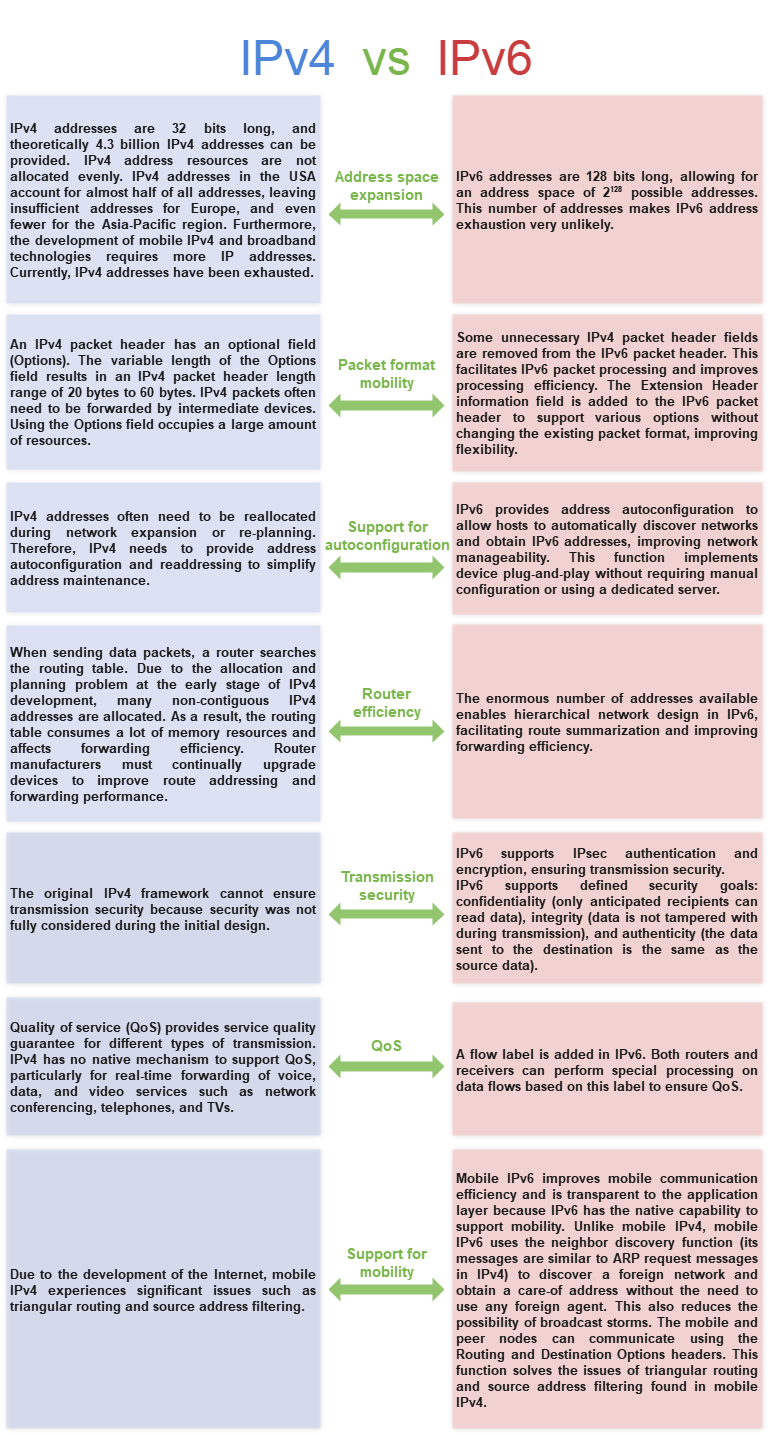What Is IPv6?
Internet Protocol version 6 (IPv6), also called IP Next Generation (IPng), is a second-generation standard network layer protocol. The network layer where IPv6 resides provides connectionless data transmission services. IPv6 is designed by the IETF as an upgraded version of IPv4 and addresses many defects in IPv4. The most significant difference between IPv6 and IPv4 is that IP addresses are lengthened from 32 bits to 128 bits. IPv6 is more competitive in future markets with its simplified header, sufficient address space, hierarchical address structure, flexible extension header, and enhanced neighbor discovery mechanism.
Why Do We Need IPv6?
Internet Protocol (IP) is a network layer protocol in the TCP/IP protocol suite. (The network layer protocol is mainly responsible for processing the transmission of IP datagrams on the network by using the routing table.) IPv4 is a widely used Internet protocol. When the Internet was starting up, IPv4 developed rapidly due to its simple design, easy implementation, and good interoperability. However, networks are developing faster and there is an acute shortage of addresses, prompting the IETF to propose IPv6, IPv7, IPv8, and IPv9 drafts in the hopes that one of them would replace IPv4. After thorough discussion, the IETF finally chose IPv6 to replace IPv4, eliminating IPv7, IPv8, and IPv9 drafts.

IPv6 evolution
Why Is IPv5 Unavailable?
In 1990, the IETF proposed the IPv5 draft. Initially, the IETF expected IPv5 to carry streaming services (such as voice and video) and IPv4 to carry data services. However, for a variety of reasons, the draft has not been widely deployed and will not be publicly used.
What Is an IPv6 Address?
An IPv6 address consists of a network prefix and an interface ID. A network prefix has n bits and is similar to the network ID in an IPv4 address; an interface identifier has (128 – n) bits and is similar to the host ID in an IPv4 address.

Structure of the IPv6 address 2001:A304:6101:1::E0:F726:4E58
An IPv6 address is 128 bits long and is represented as X:X:X:X:X:X:X:X. Each X indicates four hexadecimal characters, which are separated by colons. The IPv6 address is divided into eight groups. To make writing easier, an IPv6 address, for example FC00:0000:130F:0000:0000:09C0:876A:130B, can be abbreviated. First, we can omit the leading zeros in each group: FC00:0:130F:0:0:9C0:876A:130B. Then, we can also replace two or more consecutive groups containing only zeros with two colons (::), so the address is written as FC00:0:130F::9C0:876A:130B.
However, it is impossible to upgrade all systems on the network from IPv4 to IPv6 in a short period of time. The most effective transition solution is to embed IPv4 addresses in IPv6 ones. An original IPv4 address is a 32-bit binary number, and is expressed in dotted decimal notation to facilitate identification and memorization. The value is expressed as d.d.d.d, where each d represents a decimal integer. The four integers are separated by periods (.). Now, the IPv4 address is converted into a special IPv6 address X:X:X:X:X:X:d.d.d.d. In X:X:X:X:X:X, the first 80 bits are set to 0 and the last 16 bits are set to 1, followed by the IPv4 address. For example, if the IPv4 address is 192.168.0.1, the IPv4-embedded IPv6 address is ::FFFF:192.168.0.1.
IPv4 vs IPv6
As networks develop quickly, the design deficiencies of IPv4 are becoming more and more obvious. Compared with IPv4, IPv6 provides some new features and improvements.

IPv4 vs IPv6
Impact of IPv6 Deployment on Existing Networks and Services
- Impact of IPv6 on network performance
Enabling IPv6 on routers has little impact on high-performance routers. Typically, deploying IPv6 does not affect the network transmission delay or packet loss rate. If a router fails, IPv6 has little impact on the efficiency of updating information and calculating the optimal path.
- Impact of IPv6 on network maintenance
Using IPv6 increases engineers' maintenance workloads and requires the corresponding skills. However, IPv6 has little impact on network maintenance. Engineers capable of maintaining IPv4 can master IPv6 in a short period of time.
- Impact of IPv6 on services and applications
Existing services and applications on the IPv6 network are not affected. You can additionally access IPv6 resources. Deploying IPv6 usually requires service systems, such as the domain name system, to be adjusted. Incorrect configurations or defective software will affect your user experience.
The following briefly describes the association between IPv6 and the domain name system:
On an IPv6 network, each network device is identified by an IPv6 address. You can access the network only after obtaining the IPv6 address of the destination network device. Because 128-bit IPv6 addresses are difficult to remember, an IPv6 domain name system is established for IPv6 networks. When accessing a network device, you can directly use a domain name that is easy to remember. The server on the network resolves the domain name into an IPv6 address.
For example, Google's public domain name servers can map the domain name you enter to an IPv6 address. The IPv6 addresses of its servers are as follows:
- 2001:4860:4860::8888
- 2001:4860:4860::8844
- Author: Liu Xihan
- Updated on: 2024-02-27
- Views: 30281
- Average rating:







